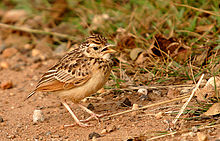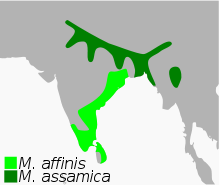- Jerdon's Bushlark
-
Jerdon's Bushlark 
A Jerdon's Bushlark near Bangalore, India.
(July, 2006)Conservation status Scientific classification Kingdom: Animalia Phylum: Chordata Class: Aves Order: Passeriformes Family: Alaudidae Genus: Mirafra Species: M. affinis Binomial name Mirafra affinis
Blyth, 1845
The Jerdon's Bushlark (Mirafra affinis) is a lark of the open countryside found in southern India. This species was earlier considered a subspecies of the Rufous-winged Bushlark (M. assamica). However recent studies of differences in call and distribution have led to it being treated as a full species.[2]
Contents
Description
M. affinis has arrowhead like spots pointing upwards on the breast. It is very similar to the Indian Bushlark (M. erythroptera) but has buffy lores, less white behind ear coverts, darker centre to wing coverts and central tail feathers. Dark centres of primary coverts are prominent, and wing panels are duller and rufous. In southern Western Ghats race ceylonensis is darker and more rufous on the underside and a longer bill.[3]
Range
M. affinis has a large range in south-east India and Sri Lanka, with an estimated global Extent of Occurrence of 100,000-1,000,000 square km.[1]
Habitat
It has proven adaptable to a variety of open habitats up to a maximum elevation of 1500m. Some of these are forest perimeters, rocky scrubland, scrubby hill meadows and clearings in open-type forests, shrub-edged unused croplands, and thickets of bamboo.[1]
Habits
Its song-flight is indistinguishable from that of Indian Bushlark, However, unlike the Indian Bushlark, Jerdon's Bushlark often perches on trees and wires.[3]
See also
External links
- BirdLife International (2008). Mirafra affinis. In: IUCN 2008. IUCN Red List of Threatened Species. Downloaded on 11 May 2009. Database entry includes justification for why this species is of Least Concern.
References
- ^ a b c Compiler: Helen Temple (2008). "Jerdon's Bushlark - BirdLife Species Factsheet". Evaluators: Jeremy Bird, Stuart Butchart, Helen Temple. BirdLife International . http://www.birdlife.org/datazone/species/index.html?action=SpcHTMDetails.asp&sid=31685&m=0. Retrieved May 9, 2009.
- ^ Alström, Per (1998). "Taxonomy of the Mirafra assamica complex". Forktail 13: 97–107 . http://www.orientalbirdclub.org/publications/forktail/13pdfs/Alstrom-Mirafra.pdf. Retrieved May 1, 2009.
- ^ a b P.C. Rasmussen and J.C. Anderton (2005). Birds of South Asia. The Ripley Guide. Lynx Edicions.

This Alaudidae-related article is a stub. You can help Wikipedia by expanding it.


